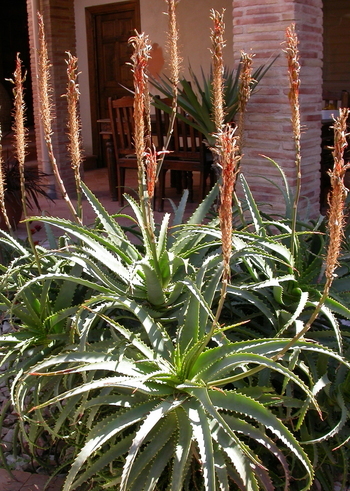
To be listed on the CAMPOSOL TODAY MAP please call +34 968 018 268.
Jobs for March/April, Cut back Aloe Arborescens
How to take cuttings from Aloe Arborescens
CUT BACK Aloe Arborescens after flowering.
This stunningly architectural plant has had it’s moment, so now’s the time to cut off the spent flower spike s and tidy the plant up for the summer. It’s really not worth leaving the plant to set seed as they are so easily propagated from cuttings.
·Either cut with a knife, or use a slight twisting action to remove spent flowerheads. Once the spikes have dried a bit more they can easily just be pulled off the plant, but look untidy for a while if not removed now.
·Remove surplus large stems to maintain the shape and structure of the plant. We often remove several of the main stems to prevent rampant growth and keep plants down to a manageable size.
Thin out some of the excess growth within and around the base of the plant. Dozens of new stems will try and grow from the base and interior, so selecting a few will dictate the structure of the plant , and give control of the shape. Removing excess will give light and air to the selected stems.
·Remove dead and damaged leaves
·All the small surplus stems and the top section of the larger stems can be potted on to make new plants. We cut to a reasonable size, remove leaves from the stem to leave a central crown, then allow the cuts to dry off overnight before potting on the next day.
It’s often not worth trying to recycle the huge stems removed from more mature plants. Although they will root , the sheer volume of material is more difficult for a growing cutting to maintain, and we end up having to remove so many of the surplus leaves, that the resulting tragic looking plant is really not worth the effort.
Smaller pieces taken from inside the plant root astonishingly quickly and grow rapidly, most will be of flowering size within a year. This pot shows plants that are about 5 months old, and are well rooted and growing strongly. Theyll be potted on singly during the next few days. In front are a few youngcuttings , taken from inside the plant. There are literally dozens that could be taken and potted on to make more plants.
Use a standard household compost mixed with approx one third grit, and don’t water in for a couple of days after potting.
Water sparingly to ensure the cutting doesn’t rot.
Put cuttings into a shaded area to allow the plants time to grow out of the fierce sun. They will root in good soil directly into the ground, but survival rates are much higher, and the plant grows more rapidlyif potted on first and grown in pots for a few months , rather than planting directly into the ground.Its logical really, our soil is 95% stones and bakes to the consistency of rock during the summer months, and its a lot easier for young roots to grow in soft potting compost.Of course, you can always dig a bigger hole and fill with compost to give the plant a better chance if you want to plant directly into the ground, but its better to use larger, stronger pieces of material, rather than softer, younger pieces.
Remove lower leaves if the plant looks stressed, and within a few months, the small plants can be repotted or planted out.
Removing the central "head" of the plant once it has established a good root system will encourage several young "heads "to form and give a rounded plant with multiple growing heads.
The plant in the main photo is now in its third year and was grown from a small cutting. Currently its a good metre and a half across and the foliage stands at about 1.2 metres, with the flowers reaching 2 metres.
These Aloes adore full sun and little water and are a striking, architectural plant that can be used for block planting or as specimens. The stunning orange red spikes flower throughout February and March, adding a vibrant feast for small birds and insects in the Spanish Spring. This spring we were privileged to be visited by several small birds who fed from the flowers right outside the back door over a period of several days, and gave a great deal of pleasure, adding to the magnificent spectacle of the plant itself,so its always with great sadness that we cut back the flowers and tidy up the plant for the summer heat.
Never mind, at least therell be plenty of cuttings for next year.
Sooty mould problems.
A reader emailed to say he had experienced a sooty mould problem with this aloe. We also had the same problem once and researching, were told that the problem was sooty mould caused by scale insects. At this point we were having an issue with scale insects, so sprayed with a suitable chemical from the agricultural suppliers and the problem stopped. Spraying with washing up liquid in water will kill off scale insects if there arent very many, but they spread in vast quantities if left unchecked, so deal with them firmly.
Don´t water these either , as they are prone to rotting off if overwatered.


































